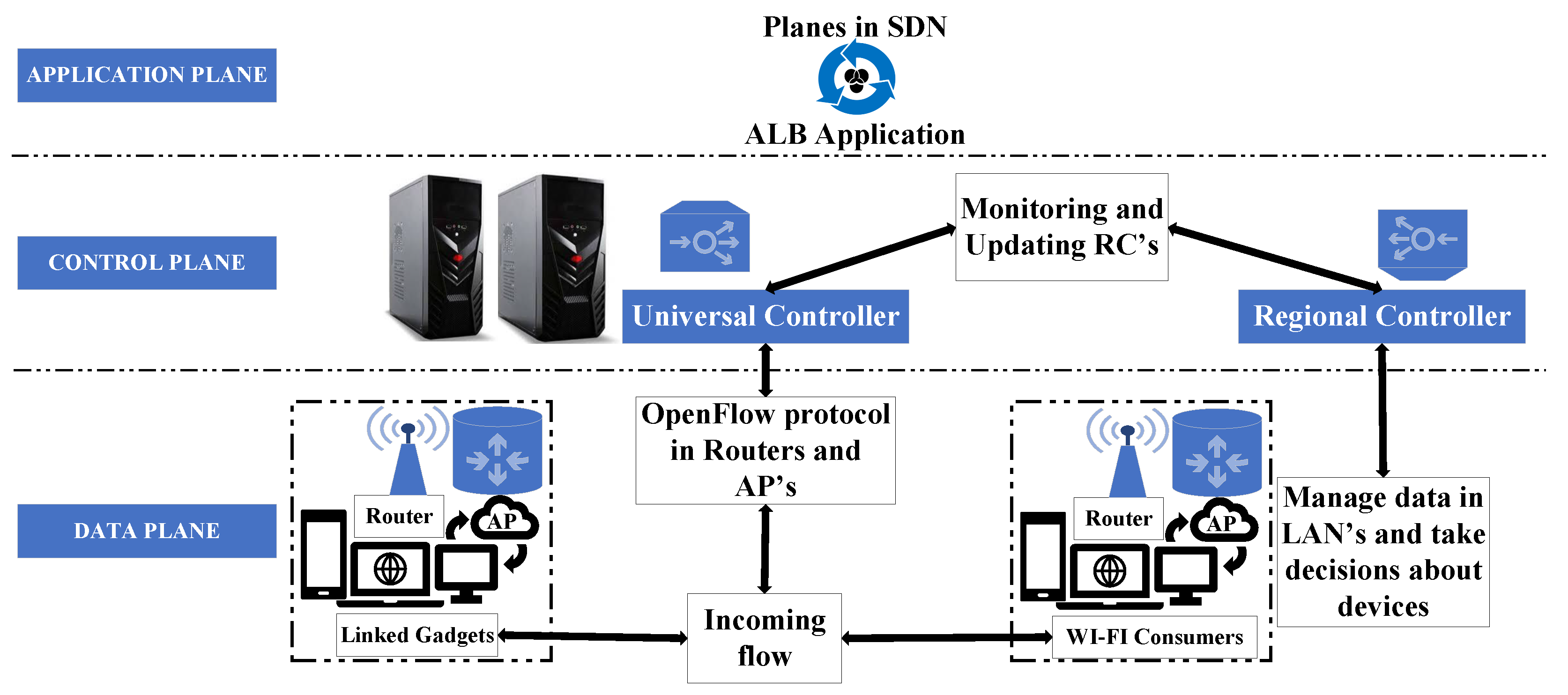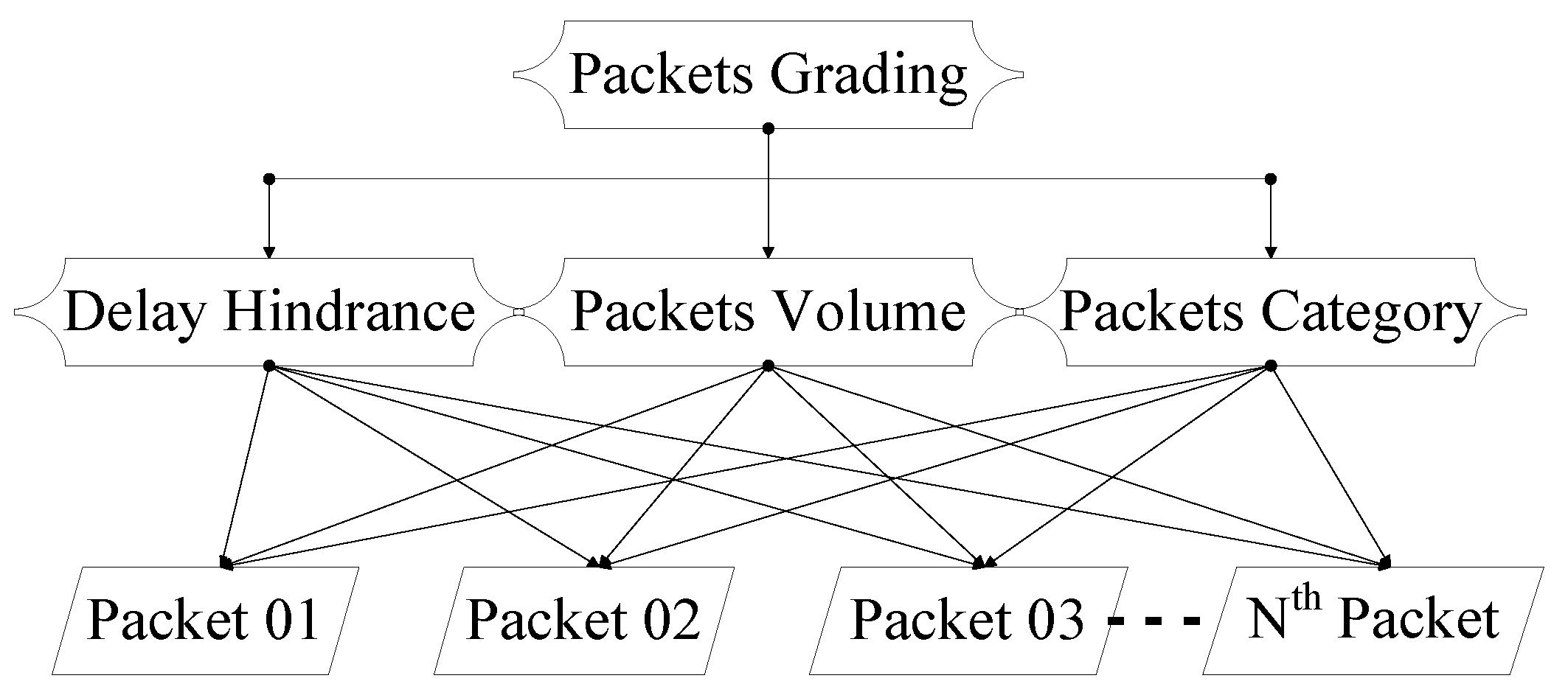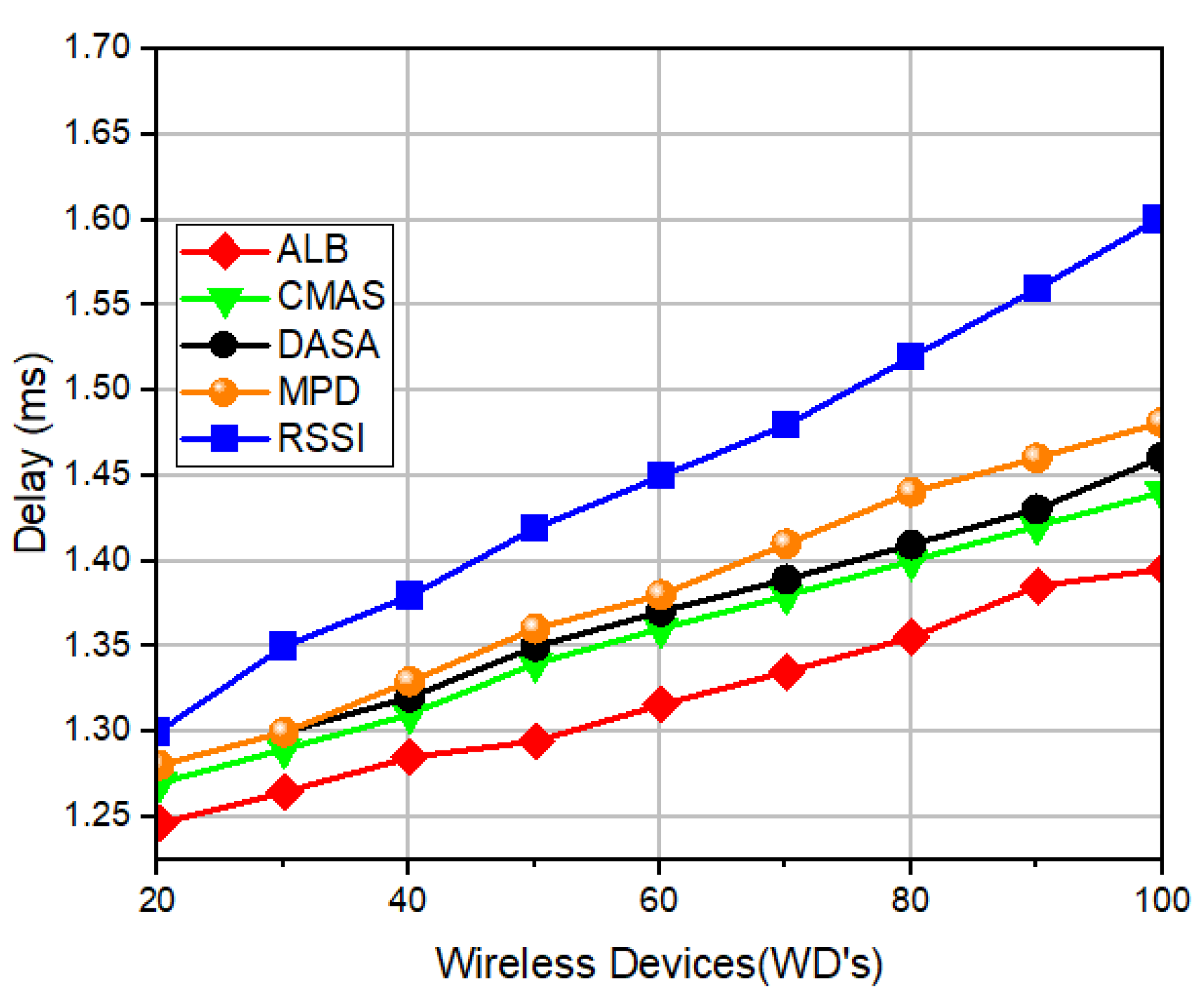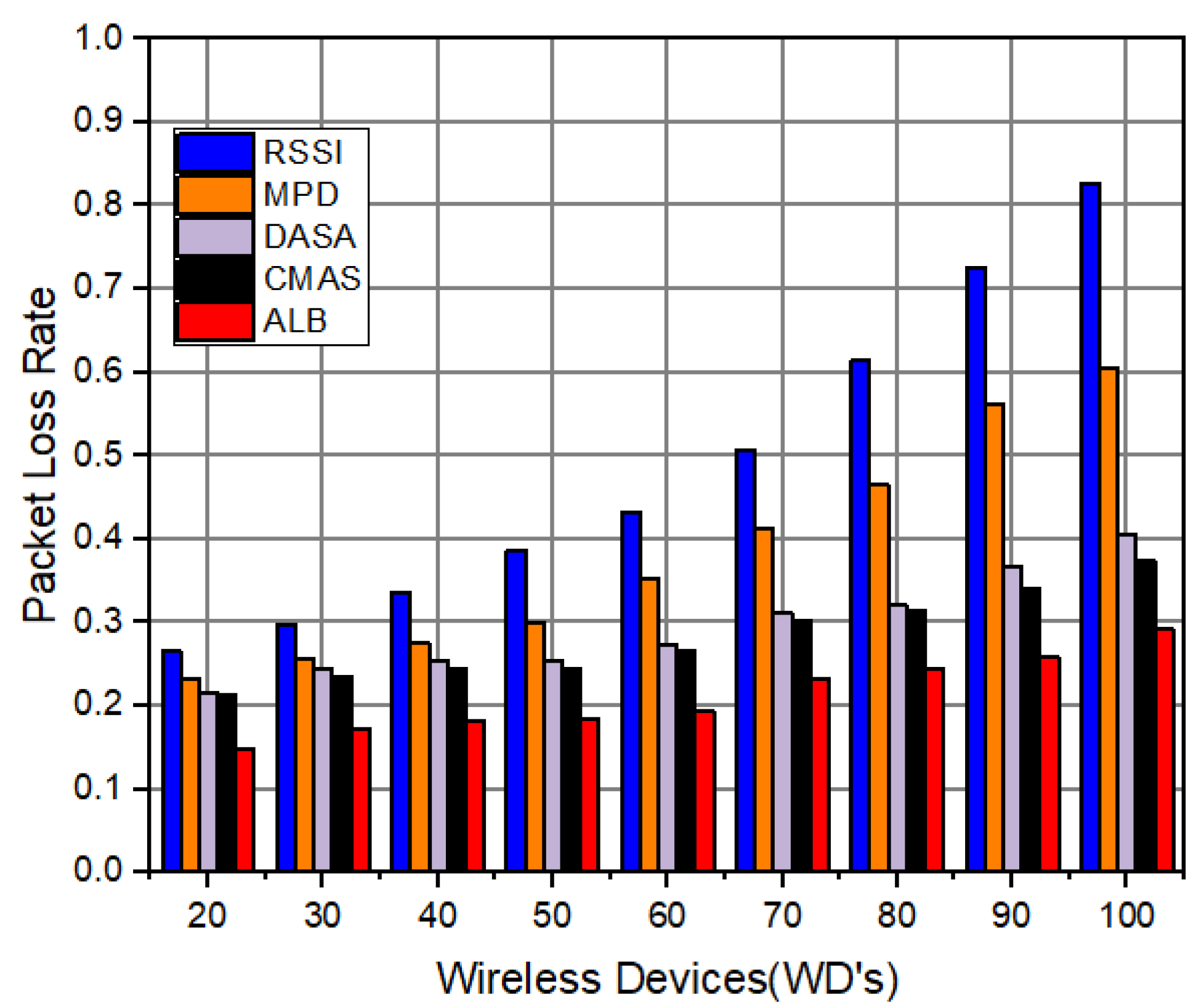An Adaptive Symmetrical Load Balancing Scheme for Next Generation Wireless Networks
Abstract
1. Introduction
- We propose an algorithm to balance the wireless traffic load in the data plane of an SD-WiFi.
- We propose an algorithm to balance the wireless traffic load in the control plane of an SD-WiFi.
- We simulate the high density SD-Wi-Fi in an OMNeT++ simulator supported by OpenFlow standards.
2. Related Work
2.1. Load Balancing in Control Plane
2.2. Load Balancing in Data Plane
3. Methodology
3.1. Algorithm 1
| Algorithm 1 Control Plane Load Balancing |
|
3.1.1. Analytical Hierarchical Process
3.1.2. Clustering
3.2. Algorithm 2
| Algorithm 2 Data Plane Load Balancing |
|
4. Simulation Setup
5. Results
5.1. Throughput
5.2. Delay
5.3. Packet Loss Rate
5.4. Average Number of Handoffs
5.5. Workload
6. Conclusions
Author Contributions
Funding
Data Availability Statement
Conflicts of Interest
References
- Alashhab, A.A.; Zahid, M.S.M.; Azim, M.A.; Daha, M.Y.; Isyaku, B.; Ali, S. A Survey of Low Rate DDoS Detection Techniques Based on Machine Learning in Software-Defined Networks. Symmetry 2022, 14, 1563. [Google Scholar] [CrossRef]
- Gao, Y.; Dai, L.; Hei, X. Throughput optimization of multi-BSS IEEE 802.11 networks with universal frequency reuse. IEEE Trans. Commun. 2017, 65, 3399–3414. [Google Scholar] [CrossRef]
- Abbas, K.; Afaq, M.; Ahmed Khan, T.; Rafiq, A.; Iqbal, J.; Ul Islam, I.; Song, W.C. An efficient SDN-based LTE-WiFi spectrum aggregation system for heterogeneous 5G networks. Trans. Emerg. Telecommun. Technol. 2022, 33, e3943. [Google Scholar] [CrossRef]
- Manzoor, S.; Yin, Y.; Gao, Y.; Hei, X.; Cheng, W. A systematic study of IEEE 802.11 DCF network optimization from theory to testbed. IEEE Access 2020, 8, 154114–154132. [Google Scholar] [CrossRef]
- Khan, S.; Akram, A.; Alsaif, H.; Usman, M. Emulating Software Defined Network using Mininet-ns3-WIFI Integration for Wireless Networks. Wirel. Pers. Commun. 2021, 118, 75–92. [Google Scholar] [CrossRef]
- Gao, Y.; Sun, X.; Dai, L. Sum Rate Optimization of Multi-Standard IEEE 802.11 WLANs. IEEE Trans. Commun. 2018, 67, 3055–3068. [Google Scholar] [CrossRef]
- Manzoor, S.; Chen, Z.; Gao, Y.; Hei, X.; Cheng, W. Towards QoS-aware load balancing for high density software defined Wi-Fi networks. IEEE Access 2020, 8, 117623–117638. [Google Scholar] [CrossRef]
- Wu, X.; O’Brien, D.C. QoS-driven load balancing in hybrid LiFi and WiFi networks. IEEE Trans. Wirel. Commun. 2021, 21, 2136–2146. [Google Scholar] [CrossRef]
- Liao, L.; Leung, V.C.; Li, Z.; Chao, H.C. Genetic algorithms with variant particle swarm optimization based mutation for generic controller placement in software-defined networks. Symmetry 2021, 13, 1133. [Google Scholar] [CrossRef]
- Zahid, T.; Hei, X.; Cheng, W.; Ahmad, A.; Maruf, P. On the tradeoff between performance and programmability for software defined WiFi networks. Wirel. Commun. Mob. Comput. 2018, 2018. [Google Scholar] [CrossRef]
- Cheng, Y.; Yang, D.; Zhou, H. Det-LB: A Load Balancing Approach in 802.11 Wireless Networks for Industrial Soft Real-Time Applications. IEEE Access 2018, 6, 32054–32063. [Google Scholar] [CrossRef]
- Ahmad, R.; Soltani, M.D.; Safari, M.; Srivastava, A. Reinforcement learning-based near-optimal load balancing for heterogeneous LiFi WiFi network. IEEE Syst. J. 2021, 16, 3084–3095. [Google Scholar] [CrossRef]
- Salman, M.; Son, J.H.; Choi, D.W.; Lee, U.; Noh, Y. DARCAS: Dynamic Association Regulator Considering Airtime Over SDN-Enabled Framework. IEEE Internet Things J. 2022, 9, 20719–20732. [Google Scholar] [CrossRef]
- Shrivastava, P.; Jamal, M.S.; Kataoka, K. EvilScout: Detection and mitigation of evil twin attack in SDN enabled WiFi. IEEE Trans. Netw. Serv. Manag. 2020, 17, 89–102. [Google Scholar] [CrossRef]
- Tewes, S.; Heinrichs, M.; Kronberger, R.; Sezgin, A. IRS-enabled Breath Tracking with Colocated Commodity WiFi Transceivers. IEEE Internet Things J. 2022. [Google Scholar] [CrossRef]
- Tyagi, S.K.S.; Pokhrel, S.R.; Nemati, M.; Jain, D.K.; Li, G.; Choi, J. Redesigning compound TCP with cognitive edge intelligence for WiFi-based IoT. Future Gener. Comput. Syst. 2021, 125, 859–868. [Google Scholar] [CrossRef]
- Adame, T.; Carrascosa, M.; Bellalta, B.; Pretel, I.; Etxebarria, I. Channel load aware AP/Extender selection in Home WiFi networks using IEEE 802.11 k/v. IEEE Access 2021, 9, 30095–30112. [Google Scholar] [CrossRef]
- Obelovska, K.; Panova, O.; Karovič, V., Jr. Performance analysis of wireless local area network for a high-/low-priority traffic ratio at different numbers of access categories. Symmetry 2021, 13, 693. [Google Scholar] [CrossRef]
- Shafi, U.; Zeeshan, M.; Iqbal, N.; Kalsoom, N.; Mumtaz, R. An Optimal Distributed Algorithm for Best AP Selection and Load Balancing in WiFi. In Proceedings of the 2018 15th International Conference on Smart Cities: Improving Quality of Life Using ICT IoT (HONET-ICT), Islamabad, Pakistan, 8–10 October 2018; pp. 65–69. [Google Scholar] [CrossRef]
- Shi, Z.; Tian, Y.; Wang, X.; Pan, J.; Zhang, X. Po-Fi: Facilitating innovations on WiFi networks with an SDN approach. Comput. Netw. 2021, 187, 107781. [Google Scholar] [CrossRef]
- Ibrar, M.; Wang, L.; Shah, N.; Rottenstreich, O.; Muntean, G.M.; Akbar, A. Reliability-aware flow distribution algorithm in SDN-enabled fog computing for smart cities. IEEE Trans. Veh. Technol. 2022, 72, 573–588. [Google Scholar] [CrossRef]
- Oni, P.B.; Blostein, S.D. Decentralized AP selection in large-scale wireless LANs considering multi-AP interference. In Proceedings of the 2017 International Conference on Computing, Networking and Communications (ICNC), Silicon Valley, CA, USA, 26–19 January 2017; pp. 13–18. [Google Scholar]
- Rani, P.; Singh, P.N.; Verma, S.; Ali, N.; Shukla, P.K.; Alhassan, M. An Implementation of Modified Blowfish Technique with Honey Bee Behavior Optimization for Load Balancing in Cloud System Environment. Wirel. Commun. Mob. Comput. 2022, 2022, 3365392. [Google Scholar] [CrossRef]
- Kut, P.; Pietrucha-Urbanik, K. Most Searched Topics in the Scientific Literature on Failures in Photovoltaic Installations. Energies 2022, 15, 8108. [Google Scholar] [CrossRef]
- Li, J.; Jiang, H.; Jiang, W.; Wu, J.; Du, W. SDN-based stateful firewall for cloud. In Proceedings of the 2020 IEEE 6th Intl Conference on Big Data Security on Cloud (BigDataSecurity), IEEE Intl Conference on High Performance and Smart Computing,(HPSC) and IEEE Intl Conference on Intelligent Data and Security (IDS), Baltimore, MD, USA, 25–27 May 2020; pp. 157–161. [Google Scholar]
- Bhowmik, C.D.; Gayen, T. Traffic aware dynamic load distribution in the Data Plane of SDN using Genetic Algorithm: A case study on NSF network. Pervasive Mob. Comput. 2022, 88, 101723. [Google Scholar] [CrossRef]
- Omer, Y.A.H.; Mustafa, A.B.A.; Abdalla, A.G. Performance analysis of round robin load balancing in SDN. In Proceedings of the 2020 International Conference on Computer, Control, Electrical, and Electronics Engineering (ICCCEEE), Khartoum, Sudan, 26–28 February 2021; pp. 1–5. [Google Scholar]
- Anbalagan, S.; Kumar, D.; Faustina, M.; Raja, G.; Ejaz, W.; Bashir, A.K. SDN-assisted efficient LTE-WiFi aggregation in next generation IoT networks. Future Gener. Comput. Syst. 2020, 107, 898–908. [Google Scholar] [CrossRef]
- Sadio, O.; Ngom, I.; Lishou, C. Controlling WiFi direct group formation for non-critical applications in C-V2X network. IEEE Access 2020, 8, 79947–79957. [Google Scholar] [CrossRef]
- Chen, W.; Lyu, F.; Wu, F.; Yang, P.; Ren, J. Flag: Flexible, accurate, and long-time user load prediction in large-scale WiFi system using deep RNN. IEEE Internet Things J. 2021, 8, 16510–16521. [Google Scholar] [CrossRef]
- Babbar, H.; Rani, S.; Gupta, D.; Aljahdali, H.M.; Singh, A.; Al-Turjman, F. Load balancing algorithm on the immense scale of internet of things in SDN for smart cities. Sustainability 2021, 13, 9587. [Google Scholar] [CrossRef]
- Cho, B.-M.; Park, K.-Y.; Park, E.-C. Fairness-aware radio resource management for medical interoperability between WBAN and WLAN. Ann. Telecommun. 2016, 71, 441–451. [Google Scholar] [CrossRef]
- Yadav, A.K.; Misra, M.; Pandey, P.K.; Liyanage, M. An EAP-Based Mutual Authentication Protocol for WLAN-Connected IoT Devices. IEEE Trans. Ind. Inform. 2022, 19, 1343–1355. [Google Scholar] [CrossRef]
- Hu, T.; Guo, Z.; Lan, J.; Zhang, J.; Zhao, W. EASM: Efficiency-Aware Switch Migration for Balancing Controller Loads in Software-Defined Networking. arXiv 2017, arXiv:1711.08659. [Google Scholar] [CrossRef]
- Alharbi, M.; Neelakandan, S.; Gupta, S.; Saravanakumar, R.; Kiran, S.; Mohan, A. Mobility aware load balancing using Kho–Kho optimization algorithm for hybrid Li-Fi and Wi-Fi network. Wirel. Netw. 2023, 1–15. [Google Scholar] [CrossRef]
- Al-Jawad, A.; Comşa, I.S.; Shah, P.; Gemikonakli, O.; Trestian, R. An innovative reinforcement learning-based framework for quality of service provisioning over multimedia-based SDN environments. IEEE Trans. Broadcast. 2021, 67, 851–867. [Google Scholar] [CrossRef]
- Barka, E.; Dahmane, S.; Kerrache, C.A.; Khayat, M.; Sallabi, F. STHM: A secured and trusted healthcare monitoring architecture using SDN and Blockchain. Electronics 2021, 10, 1787. [Google Scholar] [CrossRef]
- Bhatt, C.; Sihag, V.; Choudhary, G.; Astillo, P.V.; You, I. A Multi-Controller Authentication approach for SDN. In Proceedings of the 2021 International Conference on Electronics, Information, and Communication (ICEIC), Jeju, Republic of Korea, 31 January–3 February 2021; pp. 1–4. [Google Scholar]
- Deb, R.; Roy, S. A comprehensive survey of vulnerability and information security in SDN. Comput. Netw. 2022, 206, 108802. [Google Scholar] [CrossRef]
- Manzoor, S.; Hei, X.; Cheng, W. Towards Dynamic Two-tier Load Balancing for Software Defined WiFi Networks. In Proceedings of the 2017 2nd International Conference on Communication and Information Systems, Wuhan, China, 7–9 November 2017; pp. 63–67. [Google Scholar]










| Abbreviations | Description |
|---|---|
| ASLB | Adaptive Symmetrical Load Balancing Scheme |
| SDN | Software Define Networking |
| AP | Access Point |
| UC | Universal Controller |
| RC | Regional Controller |
| CAPWAP | Control and Provisioning of Wireless Access Points |
| AC | Access Controller |
| WLANS | Wireless Local Area Networks |
| WD | Wireless Device |
| RSSI | Received Signal Strength Indicator |
| DCF | Distributed Coordinated Function |
| OUC | Over-Utilized Controller |
| UUC | Under-Utilized Controller |
| NUC | Non-Utilized Controller |
| AHP | Analytical Hierarchical Process |
| ACH | Adaptive connection and Hand off |
| LIFO | Last In First Out |
| FIFO | First In First Out |
| COLBAS | Co-operative Load Balancing Scheme |
| HFA | HoneyBee Foraging Algorithm |
| GA | Genetic Algorithm |
| AT | Active time |
| PT | Passive time |
| MPD | Mean Probe Delay |
| CMAS | Channel Measurement-based Access Selection |
| RRM | Round-Robin Mechanism |
| WRR | Weighted Round-Robin Approach |
| VoIP | Voice over Internet Protocol |
| ESS | Extended Services Set |
| BSS’s | Basic Service Sets |
| DASA | Distributed Antenna Selection Algorithm |
| DL-SINR | Downlink Signal-to-Interference-plus-Noise Ratio |
| Symbols | Full Form |
|---|---|
| PC | Packet Category |
| L | Limit of Flow |
| Load of Regional Controller | |
| X | Central Processor Usage |
| Y | Memory Usage |
| Z | Hard Drive Usage |
| Ap | Amount of Packet Processing |
| Pb | Packets in Buffers |
| B | Burden Status |
| S | System Parameter |
| C | Consumer Parameter |
| CI | Consistency Index |
| Eigenvalue | |
| CI/RI | Consistency Ratio |
| RI | Random Index |
| Vol | Volume of Data of Aps |
| n | Number of Users AP can Maintain |
| Us | Users Currently connected to AP |
| pdp | Packet Distortion Proportion |
| B | Burden data |
| msir | Mean Signal Inaccuracy Rate |
| cpc | Central Processing Consuming |
| mu | Memory Utilization |
| Q | Utilization Level |
| Priority Level | Packets Status |
|---|---|
| Low Priority | 0 |
| Equal Priority | 1 |
| Small Priority | 2 |
| Medium Priority | 3 |
| Large Priority | 4 |
| Specifications | Value |
|---|---|
| Total Number of Controllers | 4 |
| Universal Controller | 1 |
| Regional Controllers | 3 |
| OpenFlow Switches | 2 |
| WIFI Access Points | 8 |
| WDs | 100 |
| Processors | 4 |
| RAM | 16 GB |
| Packets Table Size | 1000 |
| Packets Arrival per Second | 100 |
| Active Flow per Second | 50 |
| Passive Flow per Second | 50 |
| Load Status Refresh every | 5 s |
| Simulation Time | 20 min |
Disclaimer/Publisher’s Note: The statements, opinions and data contained in all publications are solely those of the individual author(s) and contributor(s) and not of MDPI and/or the editor(s). MDPI and/or the editor(s) disclaim responsibility for any injury to people or property resulting from any ideas, methods, instructions or products referred to in the content. |
© 2023 by the authors. Licensee MDPI, Basel, Switzerland. This article is an open access article distributed under the terms and conditions of the Creative Commons Attribution (CC BY) license (https://creativecommons.org/licenses/by/4.0/).
Share and Cite
Manzoor, S.; Mazhar, F.; Binaris, A.; Hassan, M.U.; Rasab, F.; Mohamed, H.G. An Adaptive Symmetrical Load Balancing Scheme for Next Generation Wireless Networks. Symmetry 2023, 15, 1316. https://doi.org/10.3390/sym15071316
Manzoor S, Mazhar F, Binaris A, Hassan MU, Rasab F, Mohamed HG. An Adaptive Symmetrical Load Balancing Scheme for Next Generation Wireless Networks. Symmetry. 2023; 15(7):1316. https://doi.org/10.3390/sym15071316
Chicago/Turabian StyleManzoor, Sohaib, Farrukh Mazhar, Abdullah Binaris, Moeen Uddin Hassan, Faria Rasab, and Heba G. Mohamed. 2023. "An Adaptive Symmetrical Load Balancing Scheme for Next Generation Wireless Networks" Symmetry 15, no. 7: 1316. https://doi.org/10.3390/sym15071316
APA StyleManzoor, S., Mazhar, F., Binaris, A., Hassan, M. U., Rasab, F., & Mohamed, H. G. (2023). An Adaptive Symmetrical Load Balancing Scheme for Next Generation Wireless Networks. Symmetry, 15(7), 1316. https://doi.org/10.3390/sym15071316





